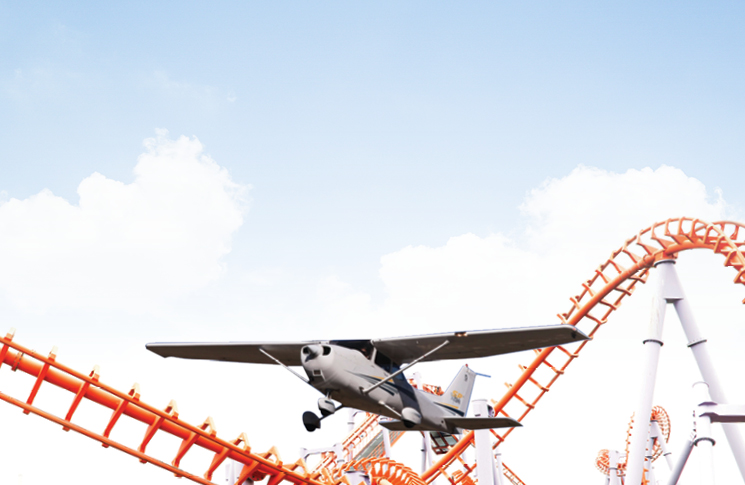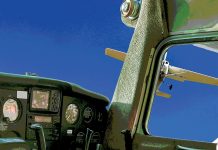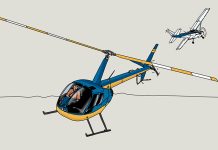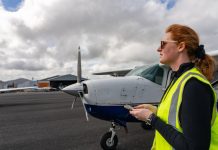An inexperienced flyer is an unknown factor, so be prepared for anything if you take one for a ride
Do you remember your first time in a small aircraft?
You were in the right-hand seat, with the pilot alongside, taking off, landing and everything in between.
That first time is an exciting mix of new sights, sounds and physical sensations; of enthusiasm, anticipation and, for some, trepidation.
You’d also agree – it’s nothing like being in a commercial airliner. And it pays to remember all of that when we ask someone to share our love of flying by joining us ‘up front’.
We didn’t really know what to expect from our first time, so why would our passenger?
A rollercoaster
Peter Kelly, of Tyabb, has had dozens of passengers in his Glasair over the course of his piloting career. One particular passenger experience helped make him aware of how he assesses first-timers, even when he personally knows them.
‘I did the important briefing stuff and she seemed calm and happy,’ he says. ‘As we were taxiing, we chatted about how we were going to climb out and all was fine.’
As he throttled up and lifted off, he noticed a strange noise – what he thought were multiple conflicting transmissions. Unperturbed, he continued. It wasn’t until he looked to the right as he turned onto crosswind that he noticed his passenger screaming!
Mentally preparing himself to complete the circuit and land, he asked, ‘Are you ok?’. Hearing his voice in her headset was enough to snap her out of it and she stopped screaming. Keeping one eye on her, he turned downwind. After some reassuring chat, she settled down and, after leaving the circuit area as planned, the flight went really well.
Back on the ground, the passenger described the lift-off as ‘a bit like a rollercoaster ride’. When you’re not used to the full-throttle energy of a light aircraft, or the runway whizzing by just a couple of feet below you, or seeing the end of the runway fast approaching, perhaps it really is a bit like a rollercoaster.
It wasn’t until he looked to the right as he turned onto crosswind that he noticed his passenger screaming!
Due to his experience as a pilot, Peter was able to quickly decide if his passenger’s screaming had placed him in an untenable situation and, therefore, he should just land, or whether he could continue.
He was also experienced enough to be able to fly the circuit as well as spending a short time being reassuring to his passenger. But it was still a lesson. ‘I think what I learnt was to try and judge more what their reactions might be before we fly,’ he says. ‘If the passenger is someone who’s not a pilot and hasn’t really flown, I pay a lot more attention now. I try to gauge how they’re going to react and what they might do. And, perhaps I’m a bit more reassuring [in the briefing] about what we are about to do.’
Overloaded and distracted
I knew my first time in a small aircraft passenger well, too; he was up for adventure but down-to-earth sensible. But, as they say, every flight is a lesson.
It was a small, quiet airfield and conditions were favourable. I’d briefed him fully, including my requirement for a sterile cockpit (no talking) during take-off and landing and the possibility of sighting other aircraft. Very little to worry about really.
You want your passengers to stay quiet in the circuit area, unless they see something the pilot should be aware of. However, what followed a typical ‘Swiss-cheese’ scenario, including not abiding by my own rules, with all the holes aligning to create a potentially dangerous situation.
The flight had gone well, but I hadn’t planned for a change to the crosswind runway on return when someone else was also coming in. I’d heard the inbound call and mentally clocked their position, noting they were intending to use a grass runway. I thought, ‘No worries, I can do that’. Calling inbound, I gave an estimated time in the circuit of about a minute after the other pilot. I wasn’t familiar with the runway, but I had read the ERSA and knew to look out for a powerline on approach.
Although I’d asked for a sterile cockpit when entering the circuit, I’d also briefed my passenger to keep an eye out for the other traffic. That ‘other traffic’, by my reckoning, should have been mid-downwind, but I hadn’t yet spotted it.
On downwind, I was checking the sock for crosswind component, scanning for power lines, trying to locate the traffic in the circuit (unsuccessfully) and also getting into my BUMPFISH pre-landing checks. A high cognitive load and my eyes inside.
At about 200 feet AGL, I realised with a jolt I hadn’t been looking out for the power line.
The other aircraft wasn’t close at all, making his call as he turned onto base, but I only heard the first few words. Glancing up, I saw what I would call, a ‘cool, sharp, fairly early turn onto base’. However, my passenger, not knowing what a ‘cool, sharp, fairly early turn onto base’ looked like, got a fright.
Possibly he’d noticed I’d had my eyes down or maybe he had been looking beyond base and wasn’t expecting the aircraft to be as close or perhaps he thought it was about to fall out of the sky? Regardless, he inadvertently let out a loud ‘Whooaaa!’ and suddenly pointed. And, because I’d been looking down, checking gauges, it was just enough to rattle me.
It’s hard to know just how much rattle equates to a decision to bail out of a circuit pattern to get back into the mindset of ‘all good’.
However, pressing on, I said, ‘Oh, that’s good, he’s on base’, hoping that was enough reassurance. Because I’d spoken, my passenger replied, ‘That looked really weird!’
We chatted, just briefly, about the sharp turn. It was probably only a few seconds but, in that time, my overloaded, slightly rattled and now distracted brain, in an un-sterile cockpit, had dumped the one thing that could pose a serious threat – the power line.
Settling down, I started the checks again. Taking a few extra seconds on downwind, I turned onto base wondering whether I’d forgotten anything or perhaps turned the fuel pump off instead of on. But, critically, because I’d done a long downwind, I was lower than expected on final.
At about 200 feet AGL, I realised with a jolt I hadn’t been looking out for the power line. Thankfully, I spotted it quickly and it was only a minor adjustment to height to keep me well clear.
Yes, all’s well that ends well, but should I have gone around and rejoined the circuit? Perhaps. Should I have prioritised circuit procedures and a sterile cockpit over reassuring the passenger with that few seconds chat? Perhaps a happy passenger in the cockpit was ultimately safer to have at that point.
There are plenty of pros and cons to each possibility. But the real lesson was – when we are distracted, particularly during a cognitive-loaded phase of flight, it’s easy for the brain to forget things. Next time, I’ll say to myself, ‘Now, where was I? Was there anything unusual that I was concerned about?’
And next time, I’ll chat with my passenger, on the ground, about how to point out other aircraft and how close they might be in the circuit. It’s not required by legislation and they might not ‘need’ to know, but hey, if it saves my brain from dropping important stuff, it will be 10 seconds well spent.
Preparation
Passenger safety briefings are typically about emergencies– they are, by nature, reactive. As a general aviation pilot, under Part 91 we are required to cover the same (appropriate) information in our safety briefing as airlines.
Some private pilots develop their own ‘passenger prep’ checklists, including, ironically, that using a checklist is normal and doesn’t mean the pilot can’t remember anything! Or that grassy runways can be bumpy. Or that the nose-up attitude a small aircraft must adopt when landing is normal and, even better, if the stall warning goes off loud and long as you’re about to touch down, you might actually be witnessing what aviators call a ‘greaser’.
When we are distracted, particularly during a cognitive-loaded phase of flight, it’s easy for the brain to forget things.
There are any number of things about you, the aircraft, the airfield or the flight itself that could be used to prepare a passenger. Arming them with pertinent information – without alarming them – not only puts them, and you, at ease, it means you’re exhibiting good airmanship by creating the safest environment for the flight.
I mean, the aim of the game is not only to show how good a pilot you are, but to keep them coming back for more, right? And you can still make it fun. Peter Kelly subsequently stuck a Dymo label to his headset that reads: ‘Don’t scream unless I do!’






A great lesson
Well learned
2 safe pilots